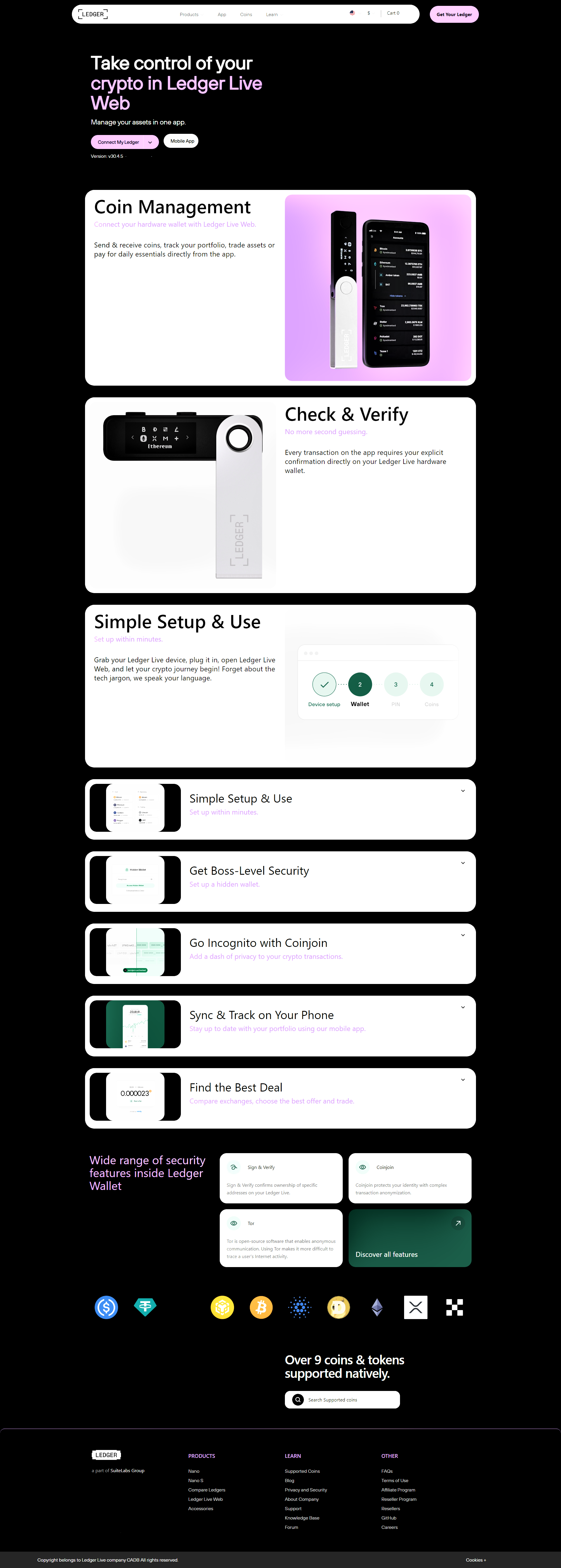Download & Install (System Requirements)
Ledger distributes its desktop companion app through its official site. Ledger Live (branded in some places as Ledger Wallet / Ledger Wallet™) is available for Windows, macOS, and Linux. Always download the desktop installer from the official Ledger website to avoid counterfeit or malicious packages.
Typical system requirements
- Windows: 64-bit Windows 10 or newer (recent Intel/AMD CPU)
- macOS: current or recent macOS builds supported by Ledger
- Linux: Debian/Ubuntu-compatible distributions (check official list)
Ledger periodically updates requirements — check the official support pages for the latest supported OS versions before installing.
Download steps (safe workflow)
- Open your browser and manually type
ledger.com/start (or visit Ledger.com and navigate to Ledger Live / Ledger Wallet downloads).
- Choose the desktop installer matching your OS and download from the official page.
- Install and launch Ledger Live, then follow the on-screen setup guide to connect your Ledger device.
Security tip: Never download Ledger software from third-party sites or follow links in unsolicited messages. Fake installers are a common attack vector used to phish seed phrases or obtain device control.
Core Features & Desktop Workflow
Ledger Live desktop functions as the central interface between you and your Ledger hardware device. The app itself never holds your private keys — keys are generated and stored only on the hardware device and are required to approve any outgoing transaction.
Portfolio dashboard
Ledger Live aggregates balances across all accounts and supported blockchains, offering historical charts, net worth breakdowns, and price alerts. The dashboard is useful for daily monitoring and high-level portfolio analysis.
Account & app management
Each blockchain (Bitcoin, Ethereum, etc.) typically requires a device “app” to be installed on your Ledger device via the app's Manager. Ledger Live lets you install/uninstall these apps, then add accounts representing addresses derived from your recovery seed.
Send/Receive & transaction verification
When you send funds, Ledger Live prepares the transaction data but the Ledger device signs it. You must physically confirm transaction details (amount, fees, destination) on the hardware device screen before the transaction is broadcast — this protects against malware that might alter transaction details on your computer.
Swap, Buy, & Staking integrations
Ledger Live integrates third-party service providers for swaps and purchases; it also supports staking for selected assets directly inside the app. Ledger displays provider options so you can compare fees and routes while still approving every step on your device.
Security Model & Best Practices
Ledger’s security model intentionally separates transaction signing (on-device) from the user interface (desktop app). The most critical security item is your recovery phrase (seed). Ledger Live will never ask you to enter your recovery phrase — if any app, site, or message requests it, treat it as malicious and stop immediately.
Recommended safety checklist
- Download Ledger Live only from ledger.com.
- Keep firmware and Ledger Live up to date (Ledger publishes release notes and updates regularly).
- Create a strong device PIN and never share it.
- Store your 24-word recovery phrase offline (paper or metal backup) and treat it as the single source of recovery.
- Verify receiving addresses on the device screen before sharing them.
- Use a passphrase (optional) for additional account separation or plausible deniability — understand tradeoffs before enabling.
Alert: Multiple published reports show attackers distributing fake Ledger desktop installers aimed at Mac and Windows users. Always verify sources and use official download pages to reduce the risk of seed-stealing malware.
Advanced Usage — Power User Features
Advanced users can leverage Ledger Live Desktop for more sophisticated workflows:
- Multiple accounts & derivation paths: create separate accounts for the same coin to segregate funds or follow different derivation schemes where supported.
- Custom fee settings: for supported networks, adjust transaction fees for faster confirmations or lower costs.
- Integrations: connect Ledger Live to dApps and Web3 tools using WalletConnect or direct integrations (always confirm on-device).
- CLI & developer workflows: Ledger provides developer tools and a repository with release notes; advanced integrations often use the device as a signer in scripting workflows.
Troubleshooting & Support
Common issues include device not detected, app install errors, or sync problems. General troubleshooting steps:
- Confirm the USB cable and port work; try another port or cable.
- Restart Ledger Live and the computer; check for OS permission prompts that block USB access.
- Ensure the device firmware is current; Ledger Live normally prompts for firmware updates during setup.
- Review Ledger Live logs or the official support articles for specific error codes.
If problems persist, contact Ledger Support through the official help center and avoid sharing your recovery phrase with anyone — support will never ask for it.
FAQ — Quick Answers
Can Ledger Live hold my private keys?
No. Ledger Live is an interface. Private keys are generated and kept on your Ledger hardware device and never leave it.
Is mobile Ledger Live required?
No — Ledger Live desktop is a full-featured experience. A companion mobile app exists for on-the-go use and Bluetooth models, but desktop remains the recommended environment for many tasks.
What if I lose my device?
Anyone with your 24-word recovery phrase can restore your wallet on another Ledger or compatible wallet. If you lose the device, use your recovery phrase to recover funds and consider moving large holdings to a newly restored device with a fresh seed.
